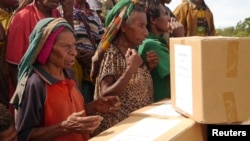Almost a month after a deadly earthquake, Papua New Guinea is struggling to get aid to desperate survivors, having allocated just a fraction of its relief funds, while a rent dispute left disaster officials briefly locked out of their offices.
The scale of the emergency is testing the finances and capacity of one of the world’s poorest countries, disaster and relief officials say, after the magnitude 7.5 quake rocked its remote mountainous highlands on Feb. 26, killing 100 people.
Thousands of survivors have walked to remote airstrips and jungle clearings, awaiting helicopters bringing supplies of food, water and medicines, aid agencies and authorities say.
“To date, we do not have any money to do all the necessary things,” Tom Edabe, the disaster coordinator for the hardest-hit province of Hela, said by telephone from Tari, its capital.
“(The) government is trying to assist and have budgeted some money, but to date we have not received anything ... we have only been given food, and non-food items supplied by other NGOs.”
Continuing aftershocks rattle residents, who have to collect water brought by daily rainstorms to ensure adequate supplies, Edabe, the disaster coordinator, said.
“The biggest thing that people need, apart from food, is water,” said James Pima, a helicopter pilot and flight manager at aviation firm HeliSolutions in the Western Highlands capital of Mt. Hagen, about 170 km (100 miles) from the disaster zone. “They don’t have clean water to cook or drink ... they are standing there staring. The expression on their faces is blank.”
His firm’s three helicopters fly relief missions “fully flat-out every day,” Pima added.
Destruction to roads and runways means authorities must rely on helicopters to fly in relief. But while nimble, the craft can carry only smaller loads than fixed-wing aircraft and cannot fly during the afternoon thunderstorms.
Lack of information
The logistics problems wind all the way to PNG’s disaster center, where officials told Reuters they had been locked out of their office in Port Moresby, the capital, for two days last week after the government missed a rental payment.
“That was correct, Monday and Tuesday,” a spokeswoman said.
In a joint report with the United Nations published Friday, the agency cited “lack of quality data” about food shortages, limited aircraft assets and “significant gaps” in sanitation support as being the biggest problems it faced.
The office of Prime Minister Peter O’Neill did not respond to emailed questions from Reuters. On his website, O’Neill has previously said, “There will be no quick fix, the damage from this disaster will take months and years to be repaired.”
The government had approved relief funds amounting to 450 million kina ($130 million), O’Neill said initially, but a later statement mentioned only 3 million kina in initial relief — or less than 1 percent — had been allocated to the worst-hit areas.
In its November budget, the government made plans to rein in spending and trim debt projected to stand at 25.8 billion kina in 2018.
Foreign aid pledges
The impoverished country is also missing its largest revenue earner, after the quake forced a shutdown of Exxon Mobil Corp’s liquefied natural gas project, which has annual sales of $3 billion at current LNG prices. The firm is still assessing quake damage at its facilities.
Foreign aid pledges of about $49 million have come in from Australia, China, the European Union, Japan, New Zealand and the United States, says the United Nations, most of it provided by private companies.
Exxon and its partner, Oil Search Ltd, say they have provided $6 million in cash and kind for quake relief.
Local officials say the scale of destruction, with villages buried by landslides and provincial towns flattened, has overwhelmed authorities in Papua New Guinea, which straddles the geologically active Pacific Ring of Fire.
“Policemen are still struggling because there is no support flying in and out,” said Naring Bongi of the quake-damaged police station in the Southern Highlands capital of Mendi.
“There is not enough food to supply care centers, they need fresh water,” he added.













